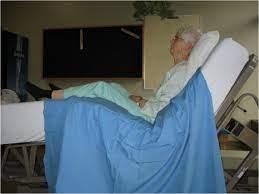The nurse is caring for a client with pulmonary edema who is short of breath and coughing pink tinged sputum. Which position should the nurse place the client to ease respiratory distress?
Left lateral position.
Reverse Trendelenburg.
High-Fowler's position.
Supine
The Correct Answer is C
A) Incorrect- The left lateral position might not provide enough lung expansion for a client in respiratory distress.
B) Incorrect- Reverse Trendelenburg (head of bed elevated, foot of bed lowered) might not provide enough lung expansion and could exacerbate respiratory distress.
C) Correct- The High-Fowler's position, where the client is sitting upright at a 90-degree angle or as upright as tolerated, helps to improve lung expansion, reduce pressure on the diaphragm, and promote optimal oxygenation. This position is commonly used for clients with respiratory distress.
D) Incorrect- The supine position may worsen pulmonary congestion and compromise lung expansion in clients with pulmonary edema.

Nursing Test Bank
Naxlex Comprehensive Predictor Exams
Related Questions
Correct Answer is C
Explanation
The correct answer is: C. Experiences facial swelling after eating crab.
Choice A Reason: Drinking a glass of water in the past 2 hours is not typically a concern unless the patient has been instructed to fast. For most cardiac catheterization procedures, patients are asked to fast for a certain period before the procedure to reduce the risk of aspiration. However, small sips of water may be allowed with medications.
Choice B Reason: While reports of left chest wall pain are clinically significant and warrant investigation, they are not as immediately concerning for the angioplasty procedure itself. Chest pain is a symptom that may have led to the decision to perform angioplasty but does not pose an immediate risk of complication during the procedure as an allergy might.
Choice C Reason: As previously mentioned, experiencing facial swelling after eating crab is indicative of a shellfish allergy. This is important because the contrast dye used in angioplasty may contain iodine, and patients with shellfish allergies could have an increased risk of an allergic reaction to the iodine in the dye. It is essential to explore this further to take necessary precautions, such as premedication with antihistamines or using a different contrast agent.
Choice D Reason: Verbalizing a fear of being in a confined space, or claustrophobia, is a psychological concern that should be addressed to ensure the patient’s comfort during the procedure. However, it does not pose a direct risk to the safety of the angioplasty procedure like an allergic reaction does. Managing patient anxiety is important, but it is not the most critical factor to explore prior to the procedure.
Correct Answer is ["A","B"]
Explanation
The correct answer is a. Inspect skin for redness and b. Use a residual limb shrinker.
Choice A rationale:
Inspecting the skin for redness is crucial to identify any signs of infection or pressure sores early. Redness can indicate irritation or the beginning of a pressure ulcer, which needs to be addressed promptly to prevent further complications.
Choice B rationale:
Using a residual limb shrinker helps to reduce swelling and shape the residual limb for prosthetic fitting. It also helps in managing pain and promoting healing by providing consistent compression.
Choice C rationale:
Avoiding range of motion exercises is incorrect. Range of motion exercises are essential to maintain joint flexibility and prevent contractures, which can hinder the use of a prosthetic limb.
Choice D rationale:
Applying alcohol to the residual limb after bathing is not recommended. Alcohol can dry out the skin and cause irritation, which can lead to skin breakdown and infection. Instead, the residual limb should be kept clean and moisturized with appropriate skin care products.
Whether you are a student looking to ace your exams or a practicing nurse seeking to enhance your expertise , our nursing education contents will empower you with the confidence and competence to make a difference in the lives of patients and become a respected leader in the healthcare field.
Visit Naxlex, invest in your future and unlock endless possibilities with our unparalleled nursing education contents today
Report Wrong Answer on the Current Question
Do you disagree with the answer? If yes, what is your expected answer? Explain.
Kindly be descriptive with the issue you are facing.
